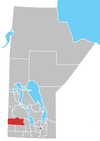Keeseekoowenin Ojibway First Nation
Keeseekoowenin 61 | |
|---|---|
| Indian Reserve 61 | |
 IR 61 Location of Keeseekoowenin Ojibway First Nation in Manitoba | |
| Coordinates: 50°33′09″N 100°18′06″W / 50.552598°N 100.301743°WCoordinates: 50°33′09″N 100°18′06″W / 50.552598°N 100.301743°W | |
| Country | |
| Province | |
| Region | Westman |
| Area | |
| • Land | 57.2 km2 (22.08 sq mi) |
| Population (2016)[2] | |
| • Total | 386 |
| • Density | 17.5/km2 (45/sq mi) |
| Time zone | UTC-6 (Central (CST)) |
| • Summer (DST) | UTC-5 (Central (CDT)) |
| Keeseekoowenin Ojibway First Nation Giizhigoowining | |
| People | Anishinabe / Ojibway |
| Treaty | Treaty 2 |
| Province | Manitoba |
| Land | |
| Main reserve | Keeseekoowenin 61 |
| Other reserve(s) | IR 61A[1] and IR 61B
|
| Tribal Council | |
| West Region Tribal Council | |
| Website | |
| keeseekoowenin | |
Keeseekoowenin Ojibway First Nation (KOFN; also known as Riding Mountain Band) is a First Nations community primarily located on Keeseekoowenin 61 (Indian Reserve 61A), situated near Elphinstone, Manitoba, south of Riding Mountain National Park.[3]
The reserve is surrounded by territory of the Rural Municipality of Yellowhead, in whose northeastern portion it lies.[4][5] The KOFN also two smaller reserves: IR 61A, which is located within Riding Mountain National Park, on the northwest shore of ; and IR 61B, which is located between the two other reserves by Bottle Lake.[3][4][5]
Origins[]
The reserve was established around Riding Mountain House, a trading post of the Hudson's Bay Company that operated from 1860 until 1895.[6][7] The Keeseekoowenin Ojibway, also known as Riding Mountain Band, signed Treaty 2 with the Government of Canada on 21 August 1871.[3]
The group takes their name from Keeseekoowenin, who was Chief when they moved to the reserve in 1875.[8]
In 1935, the Sovereign Okanase Indian Nation, known as the Clear Water Lake Indian Tribe, were burned out of the Clear Water Lake Indian Territory of current-day Riding Mountain National Park and relocated within the Indian Reserve (IR) 61. In 1994, a land claim settlement awarded Keeseekoowenin Ojibway First Nation the IR 61A to the location on the boundaries of the National Park.[4][5]
Reserves[]
The Keeseekoowenin Ojibway First Nation has 3 separate reserve lands.[3]
The main reserve, Keeseekoowenin 61 (IR 61A), is situated south of Riding Mountain National Park, in a valley setting with the Little Saskatchewan River flowing through it. The second reserve (IR 61A) is located within the park, on the northwest shore of . The third, called Bottle Lake 61B, is located in between the two other reserves.[3]
References[]
- ^ https://www.pc.gc.ca/en/pn-np/mb/riding/autochtones-indigenous-cultures/autochtones-indigenous/keeseekoowenin
- ^ https://www12.statcan.gc.ca/census-recensement/2016/dp-pd/prof/details/page.cfm?Lang=E&Geo1=CSD&Code1=4615067&Geo2=PR&Code2=46&SearchText=Keeseekoowenin%2061&SearchType=Begins&SearchPR=01&B1=All&GeoLevel=PR&GeoCode=4615067&TABID=1&type=0
- ^ Jump up to: a b c d e "History – keeseekoowenin Ojibway". Retrieved 2021-08-15.
- ^ Jump up to: a b c "Keeseekoowenin". Indian and Northern Affairs Canada. Archived from the original on 2012-05-27. Retrieved 2011-10-14.
- ^ Jump up to: a b c "Keeseekoowenin". Aboriginal Canada Portal. Archived from the original on 2012-04-03. Retrieved 2011-10-14.
- ^ "RIDING MOUNTAIN BIOSPHERE RESERVE Periodic Review Report" (PDF). 2000. pp. 18–19. Archived from the original (PDF) on 2012-04-25. Retrieved 2011-10-24.
- ^ Trevor E. Lockhart (2000). "Water Management Issues in the Turtle River Watershed Conservation District" (PDF). National Library of Canada. Retrieved 2011-10-24.
- ^ Neufeld, Peter Lorenz (1994). "KEESEEKOOWENIN". In Cook, Ramsay; Hamelin, Jean (eds.). Dictionary of Canadian Biography. XIII (1901–1910) (online ed.). University of Toronto Press. Retrieved 2011-10-24.
External links[]
- First Nations governments in Manitoba
- West Region Tribal Council
- Manitoba geography stubs
- First Nations in Southern Manitoba

